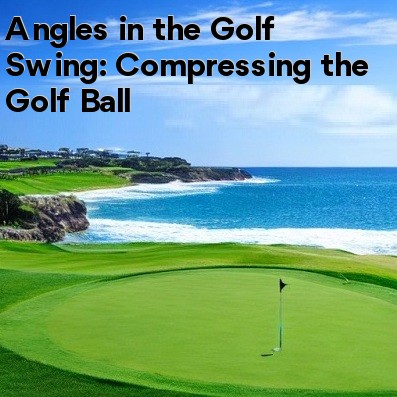
In golf, Angles in the Golf Swing: Compressing the Golf Ball
Compressing the golf ball is one of the key factors in achieving maximum distance and control in your shots. It involves creating and maintaining the proper angles in your golf swing to generate the right amount of power and accuracy. Understanding and executing these angles is crucial for any golfer looking to improve their game. Let's take a closer look at the angles in the golf swing that contribute to compressing the golf ball.
Address Position:
- Start by positioning yourself correctly at address. This involves having a neutral spine angle with your chin slightly up, and your weight evenly distributed between your feet.
- Ensure that your arms are extended comfortably, keeping the clubhead square to the target line. This sets the foundation for creating the proper angles in your swing.

Takeaway:
- During the takeaway, focus on keeping your left arm straight (right arm for left-handed golfers) and maintaining the angle formed between the clubshaft and your left forearm.
- Avoid collapsing the angle too early, as this can lead to a loss of power and consistency in your swing.
Backswing:
- As you rotate your upper body away from the target, maintain the angle between your left arm and the clubshaft.
- Proper hip rotation and shoulder turn will help you create more power and coil in your backswing, allowing for a more explosive downswing.
Transition:
- The transition from backswing to downswing is critical for generating maximum compression on the golf ball.
- Start by initiating the downswing with your lower body, shifting your weight onto your front foot, and then allow your hands and arms to follow.
- Maintain the angle formed between your left arm and the clubshaft as you bring the club down towards impact.
Impact:
- At impact, the most important angle to focus on is the one formed between your left arm and the clubshaft.
- Strike the golf ball with a slightly descending blow, compressing it against the ground for maximum distance and control.
- Rotate your hips and allow your arms to extend naturally through the ball, maintaining the desired angle.
Follow-through:
- After impact, continue the swing with a full follow-through, allowing your body to rotate and your arms to extend fully.
- This completes the transfer of energy from your body to the golf ball, ensuring maximum compression and distance.
Yes, compressing the golf ball is important for hitting the ball longer and straighter. When you compress the ball, you are squeezing it between the clubface and the ground. This causes the ball to deform and release more energy, which results in a longer and straighter shot.
There are a few things you can do to compress the golf ball:
- Make sure you are using the correct club. The club you use should be the right loft for the distance you are trying to hit.
- Make sure you are hitting the ball on the sweet spot. The sweet spot is the area on the clubface where the ball will compress the most.
- Make sure you are making a good contact with the ball. This means that you should hit the ball squarely in the center of the clubface.
- Swing the clubhead with speed. The faster you swing the clubhead, the more energy you will transfer to the ball, which will result in a longer and straighter shot.
Here are some common mistakes to avoid when it comes to compressing the golf ball:
- Using the wrong club. Using a club that is too lofted will make it difficult to compress the ball.
- Hitting the ball off the toe or heel of the clubface. This will cause the ball to skid off the clubface and lose energy.
- Making a slow swing. A slow swing will not transfer enough energy to the ball, which will result in a shorter and less accurate shot.
By following these tips, you can learn to compress the golf ball and hit the ball longer and straighter.
Here are some additional tips for compressing the golf ball:
- Practice hitting balls with a purpose of hitting the ball on the sweet spot. This will help you to develop the muscle memory needed to make good contact with the ball.
- Get lessons from a qualified golf instructor. A good instructor can help you identify any flaws in your swing and develop a plan to improve your ball compression.
- Use a launch monitor to track your ball speed and clubhead speed. This will help you to see how much energy you are transferring to the ball and make adjustments to your swing as needed.
With a little practice, you can learn to compress the golf ball and hit the ball longer and straighter.
Q1: What does it mean to “compress” the golf ball? A: Compressing the golf ball refers to the process of striking the ball with a descending blow, effectively squishing it between the clubface and the ground.
Q2: Why is compressing the golf ball important? A: Compressing the ball maximizes the energy transfer from the club to the ball, resulting in better distance, control, and spin.
Q3: How does the angle of attack affect ball compression? A: A steeper angle of attack, with the club descending into impact, facilitates better ball compression.
Q4: How does ball position impact compression? A: Ball position further back in the stance encourages a descending blow, enhancing ball compression.
Q5: Can improper ball position hinder ball compression? A: Yes, if the ball is too far forward, it can lead to a more shallow angle of attack, reducing ball compression.
Q6: How does a golfer's swing speed affect ball compression? A: Faster swing speeds generate more force and can result in greater ball compression.
Q7: Is ball compression necessary for all shots? A: While compression is desirable for most full shots, delicate shots around the green may not require as much compression.
Q8: What are the benefits of compressing the ball? A: Compressing the ball results in increased distance, better control, and the ability to shape shots.
Q9: How does a golfer's skill level impact their ability to compress the ball? A: Skilled golfers tend to have better ball-striking consistency, leading to more effective ball compression.
Q10: Can club selection affect ball compression? A: Different clubs require adjustments to achieve optimal compression based on loft and desired shot shape.
Q11: How does swing path influence ball compression? A: An inside-to-out swing path can help achieve a slightly downward angle of attack, promoting ball compression.
Q12: Can ball compression help with consistency in shot distance? A: Yes, compressed shots are more consistent in terms of both distance and accuracy.
Q13: Are there specific drills to practice ball compression? A: Working on proper ball position, angle of attack, and divot patterns through drills can help improve ball compression.
Q14: Can modern club technology enhance ball compression? A: Modern club designs can help golfers achieve better compression by optimizing the interaction between the clubface and the ball.
Q15: How can golfers work on improving their ability to compress the ball? A: Practicing with different clubs and paying attention to angle of attack and ball position during practice sessions can lead to better compression.
Conclusion
Understanding and implementing the proper angles in your golf swing is crucial for compressing the golf ball and achieving the desired distance and control. Pay attention to your address position, takeaway, backswing, transition, impact, and follow-through to ensure that you maintain the correct angles throughout your swing. Practice these angles with focus and consistency, and you'll soon see improvements in your game.






